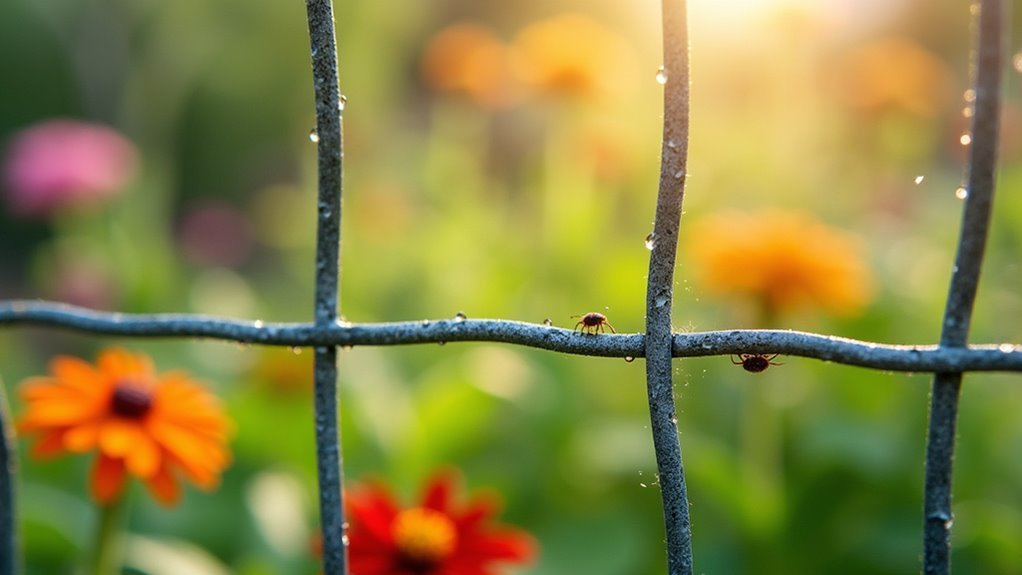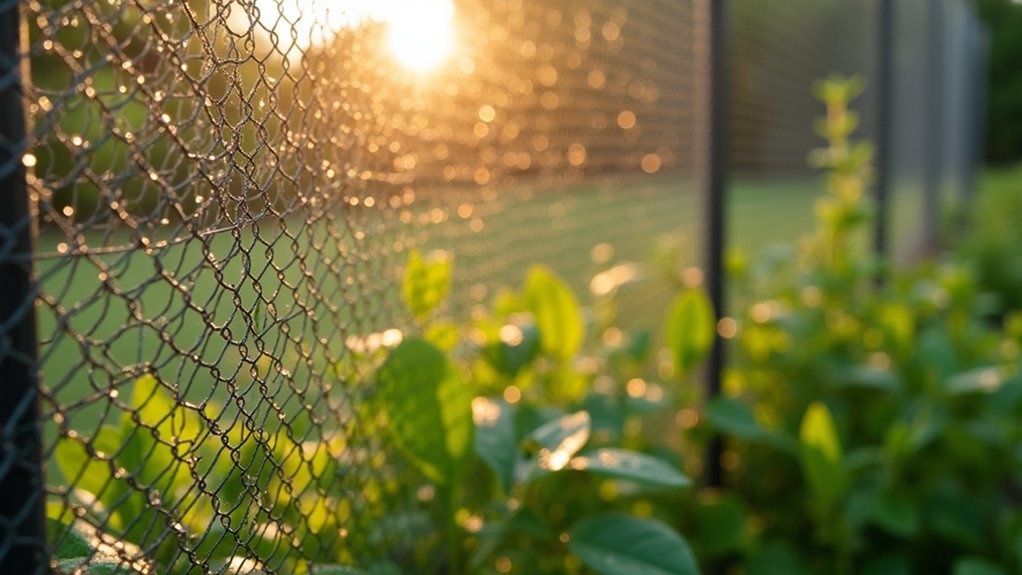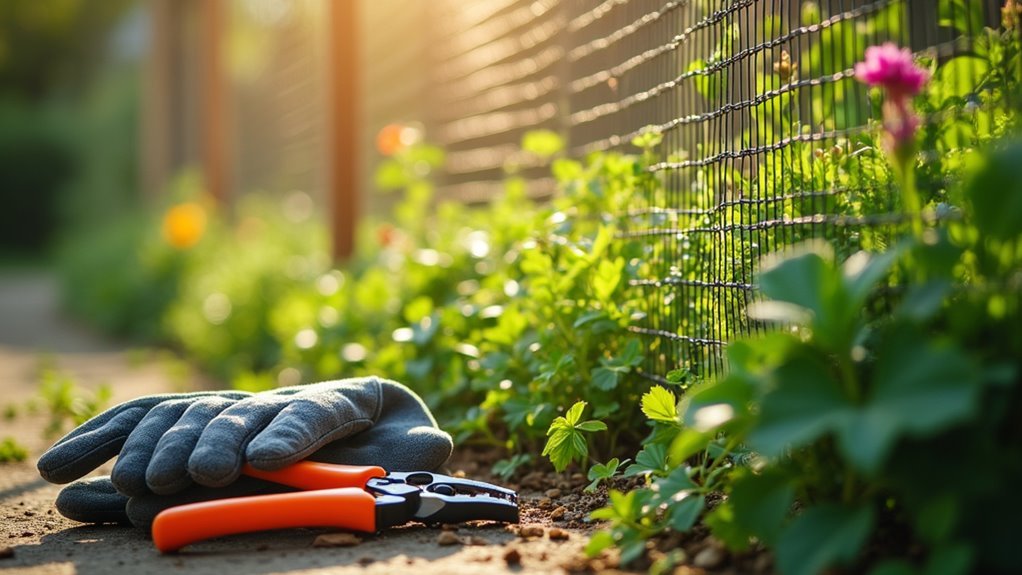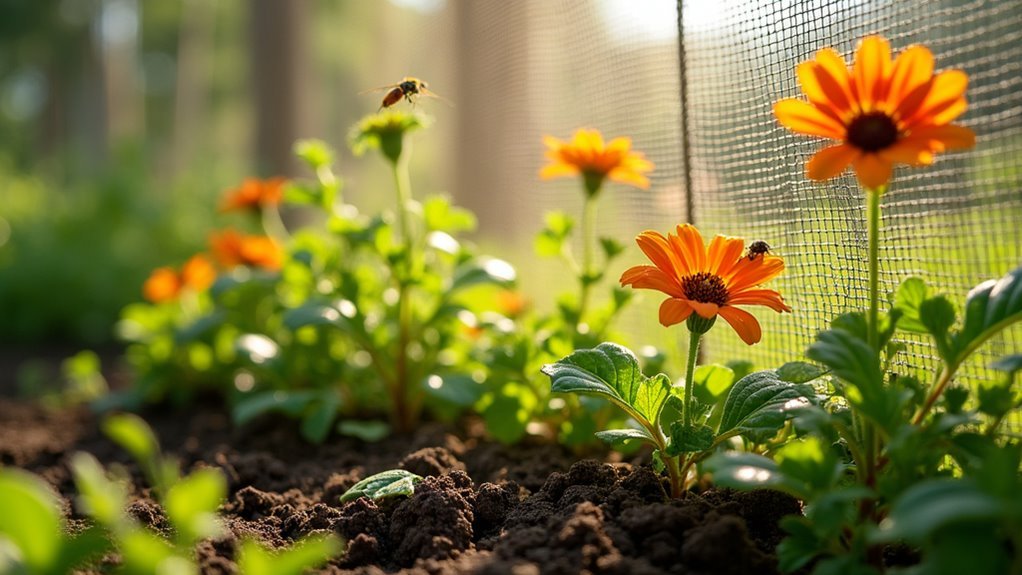You can stop garden pests effectively with wire mesh barriers by selecting the right opening size for your specific problem. Use 1/16-inch mesh for tiny invaders like aphids and thrips, 1/4-inch hardware cloth for chipmunks and caterpillars, and 1-inch openings for rabbits while maintaining airflow. Install mesh two feet high and bury it several inches deep, angling it outward to prevent digging. The complete strategy involves understanding materials, installation techniques, and maintenance practices.
Understanding Wire Mesh for Garden Protection

When you’re battling garden pests, wire mesh barriers offer one of the most reliable physical solutions to protect your plants.
Wire mesh fencing creates an effective physical barrier that prevents pests from accessing your valuable crops and flowers. You’ll find these barriers particularly useful against rabbits, squirrels, and various insects that commonly damage gardens.
The key to successful garden protection lies in selecting the right mesh specifications. You need smaller openings to block tiny pests, while 1-inch diameter holes effectively stop larger animals.
You can customize thickness and gauge based on your specific needs, with thicker wires providing enhanced durability against weather conditions. Different materials like galvanized or stainless steel offer varying corrosion resistance levels, ensuring your investment lasts longer while maintaining ideal pest prevention capabilities.
Common Garden Pests That Wire Mesh Stops
Because garden pests vary dramatically in size and behavior, wire mesh barriers excel at stopping different types of invaders through targeted mesh specifications.
Wire mesh effectively deters rabbits and squirrels when installed at least two feet high, preventing these jumping animals from accessing your garden beds.
Two-foot-high wire mesh creates an effective barrier that stops rabbits and squirrels from jumping into your garden beds.
You’ll keep pests like aphids and caterpillars out using 1/4-inch hardware cloth with smaller openings.
Underground, mesh buried two feet deep stops moles from tunneling into garden areas. For groundhogs, angled outward mesh prevents digging under barriers.
Fine mesh netting protects against birds and larger insects while allowing light and water through.
Garden pests including both above-ground and below-ground invaders can’t penetrate properly installed wire barriers.
Types of Wire Mesh Materials and Gauges

Several wire mesh materials offer distinct advantages for garden pest control, with stainless steel, galvanized steel, and polyester-coated options leading the market. When selecting types of wire mesh for pest protection, you’ll need to evaluate both material durability and wire specifications.
| Material | Best Use |
|---|---|
| T-304/T-316 Stainless Steel | High corrosion resistance |
| Galvanized Welded Mesh | Cost-effective durability |
| Polyester-Coated Wire | Weather protection |
The gauge of wire determines your mesh’s strength—lower numbers mean thicker, stronger wire. You’ll typically find wire diameters ranging from 0.025 to 0.032 inches. For effective rodent and bird control, choose 1/4-inch hardware cloth with appropriate gauge ratings. Thicker wires provide sturdier barriers against determined pests, while smaller opening sizes exclude tinier invaders more effectively.
Choosing the Right Mesh Size for Different Pests
How do you determine which mesh opening size will effectively stop your garden’s specific pest problems?
You’ll need to match your wire mesh to the smallest pests you’re targeting. For tiny invaders like aphids and thrips, choose mesh size openings of 1/16 inch or smaller to block their access completely.
Chipmunks and small rodents require 1/4-inch openings to prevent them from squeezing through your barriers. Larger garden pests such as rabbits need only 1-inch mesh for effective pest exclusion while maintaining proper airflow.
Match mesh size to your target pest: 1/4-inch openings stop chipmunks while 1-inch mesh effectively excludes rabbits without restricting airflow.
Don’t forget wire thickness when selecting your mesh. Lower gauge numbers mean thicker wire that resists chewing from determined animals.
Balance your pest exclusion needs with plant health requirements by ensuring adequate light and air circulation through your chosen wire mesh.
Safety Equipment Needed for Wire Mesh Installation

Protection becomes your top priority when working with wire mesh, as sharp edges and flying debris pose real risks to your hands and eyes.
You’ll need heavy gloves to shield against scratches and puncture wounds from sharp wire edges. Safety glasses are essential when cutting mesh, preventing tiny wire pieces from injuring your eyes as they flip up during the process.
Use proper wire cutters designed for your specific wire gauge to guarantee clean cuts and maintain control while handling the material.
Work in well-ventilated areas to avoid inhaling dust or debris generated during installation. Keep a first aid kit nearby for treating minor injuries that may occur.
These precautions transform a potentially hazardous task into a safe, manageable project.
Cutting and Shaping Wire Mesh Properly
Once you’ve gathered your safety equipment, accurate measuring and cutting become the foundation of successful wire mesh installation. First, measure and mark your desired dimensions on the mesh to minimize waste and guarantee precision. Use wire cutters or snips specifically designed for your mesh’s gauge – this ensures clean cuts and reduces injury risks during the cutting process.
| Wire Gauge | Recommended Tool | Cutting Difficulty |
|---|---|---|
| Light (14-16) | Standard wire snips | Easy |
| Medium (10-12) | Heavy-duty cutters | Moderate |
| Heavy (6-8) | Aviation snips | Challenging |
Thicker wire meshes require more robust tools and techniques for effective shaping. Always maintain your safety protocols – wear heavy gloves and safety glasses throughout the cutting process to protect against sharp edges and flying wire pieces.
Building Wire Mesh Fences for Larger Animals
Larger animals like deer, rabbits, and groundhogs pose significant challenges that require more substantial fencing solutions than simple garden barriers.
You’ll need wire mesh fences that reach at least eight feet high to effectively stop deer from jumping over into your garden. For burrowing animals like groundhogs, bury several inches of wire mesh at the base and angle it outward to prevent tunneling underneath your fence.
Proper anchoring is essential when installing these fences to withstand wind pressure and prevent larger animals from pushing through weak spots.
Strong fence anchoring prevents wind damage and stops determined animals from finding structural weaknesses to exploit.
Choose appropriate mesh sizes based on your specific garden pests – one-inch chicken wire works for most animals, but you’ll need 1/4-inch hardware cloth for smaller creatures.
Regular maintenance and inspections guarantee your fence remains effective against persistent wildlife.
Creating Wire Mesh Cages for Individual Plants
When you’re building wire mesh cages for individual plants, you’ll need to guarantee proper height and underground securing to maximize protection.
Make your cages at least two feet tall to prevent rabbits and other jumping pests from accessing your plants.
Don’t forget to bury a portion of the mesh underground to block burrowing animals from reaching plant roots.
Proper Cage Height Selection
Selecting the right cage height determines whether your wire mesh barriers will successfully protect your plants from garden pests. You’ll need different heights depending on which pests you’re targeting and your plant’s mature size.
| Pest Type | Recommended Height | Wire Mesh Size | Additional Notes |
|---|---|---|---|
| Rabbits/Deer | 3-4 feet | 1/2-1 inch | Jumping deterrent |
| Small pests (aphids) | 1-2 feet | 1/4 inch | Easy plant access |
| Caterpillars | 1-2 feet | 1/4 inch | Hardware cloth ideal |
| Burrowing animals | Variable | Any size | Bury 6+ inches deep |
When sizing your cage height, consider your plant’s full growth potential. You don’t want the wire mesh restricting development. Always secure the base by burying several inches underground to prevent burrowing animals from tunneling underneath your barriers.
Securing Mesh Underground
Proper underground installation forms the foundation of effective wire mesh cages that’ll keep burrowing pests from reaching your plants.
You’ll need to bury the mesh at least two feet deep to prevent moles and voles from tunneling underneath your protective barrier. This underground extension creates an impenetrable wall that stops these persistent pests from accessing plant roots and bulbs.
To secure the wire mesh properly, use landscaping pins or heavy-duty stakes around the perimeter. Drive these anchoring points deep into the soil, ensuring the mesh remains taut and positioned correctly.
The underground portion should extend outward slightly at the bottom, creating an L-shaped barrier that further discourages digging attempts. This installation method guarantees your mesh stays firmly in place against wind and determined animals.
Installing Underground Wire Barriers Against Burrowing Pests
When you’re dealing with moles, voles, and other burrowing pests, underground wire barriers create an effective defense around your garden perimeter.
You’ll need to focus on burying the mesh at the proper depth to block underground access routes.
The installation technique you use to secure the barrier will determine whether pests can breach your garden’s defenses.
Proper Burial Depth Requirements
Although surface-level deterrents might seem sufficient, you’ll need to dig much deeper to create an effective barrier against persistent burrowing pests.
The proper burial depth for wire mesh requires at least two feet underground to effectively stop moles and voles from tunneling beneath your protection. This underground protection must extend well below their typical digging patterns.
Don’t forget the above-ground component—you’ll need a minimum of six inches of mesh extending upward to prevent these burrowing pests from simply climbing over your barrier.
When installing your wire mesh, bury it at an outward angle from the base rather than straight down. This angled installation creates an additional obstacle that makes digging attempts considerably more difficult for determined pests.
Securing Mesh Installation Techniques
Three critical steps will guarantee your underground wire barrier stays secure and functional for years.
First, angle your wire mesh outward from your garden area during installation to discourage burrowing pests from digging underneath. This angled positioning creates a psychological and physical deterrent that redirects animals away from your protected space.
Second, overlap mesh sections by at least four inches and secure joints with heavy-duty zip ties or wire fasteners to eliminate weak points.
Third, compact soil firmly around the buried portion while ensuring the mesh maintains its structural integrity. These installation techniques prevent gaps that clever burrowing pests exploit.
Regular inspection of connection points and proper soil compaction will maintain your barrier’s effectiveness against persistent garden invaders.
Protecting Trees With Wire Mesh Guards
Since young trees are particularly vulnerable to damage from deer, rabbits, and rodents, you’ll need to create a protective barrier that safeguards their delicate bark and developing trunks.
Wire mesh guards provide effective protection when installed properly around young trees.
Properly installed wire mesh guards offer young trees essential protection from deer, rabbits, and other damaging pests.
Install the guard loosely around the trunk to prevent constricting growth that could injure the tree. Extend the mesh several inches above ground while burying a few inches underground to stop burrowing animals.
Use 1/4-inch hardware cloth for maximum effectiveness against pests like rabbits and smaller rodents, as larger gaps allow unwanted access.
Conduct regular inspections throughout the year to ascertain your guards remain intact and continue providing reliable protection against pest intrusion.
Wire Mesh Height and Depth Requirements
You’ll need to take into account both minimum height standards and proper burial depth when installing wire mesh barriers around your garden.
Your fence should stand at least two feet tall to effectively stop rabbits and other jumping pests from clearing the barrier.
Don’t forget to bury several inches of mesh underground at an outward angle to prevent burrowing animals from digging underneath your protection.
Minimum Height Standards
Two critical factors determine whether your wire mesh barrier will successfully protect your garden: proper height and adequate depth.
Understanding minimum height standards for wire mesh fences guarantees effective pest exclusion against various garden invaders.
For rabbit protection, you’ll need fencing at least two feet tall to prevent jumping.
Deer require considerably taller barriers—non-electric fencing must reach eight feet minimum to discourage these agile creatures from leaping over your defenses.
Don’t forget about burrowing animals when planning your barrier height.
You’ll need at least six inches of wire mesh above ground level for effective rodent exclusion.
This above-ground portion works alongside your buried mesh to create a complete defense system that stops both jumping and digging pests from accessing your plants.
Proper Burial Depth
While proper height stops jumping pests, underground protection requires strategic burial depth to block determined diggers and tunnelers.
You’ll need to bury several inches of wire mesh below ground level, angling it outward to prevent groundhogs from burrowing underneath your barrier. For moles specifically, dig at least two feet deep while maintaining six inches above ground to effectively block their extensive tunneling networks.
The proper burial depth varies by target garden pests, but don’t skimp on depth requirements. Shallow installations create weak points that persistent animals will exploit.
When you angle the buried portion outward, you’re creating an L-shaped deterrent that forces diggers to abandon their efforts.
Securing Wire Mesh Against Weather and Animal Pressure
Once you’ve installed your wire mesh barriers, securing them properly becomes essential for long-term effectiveness against both weather elements and persistent garden pests. You’ll need sturdy landscaping pins to anchor your mesh firmly against strong winds and prevent uplift. Choose thicker wire gauge for enhanced durability, as lower numbers indicate stronger material that resists bending under animal pressure.
| Security Measure | Weather Protection | Animal Deterrence |
|---|---|---|
| Landscaping pins | Prevents wind uplift | Maintains barrier integrity |
| Buried mesh edges | Resists ground frost | Stops burrowing animals |
| Thick wire gauge | Withstands storms | Resists animal damage |
| Regular inspections | Catches rust early | Identifies breach points |
| Proper height | Reduces wind stress | Deters climbing pests |
Regular inspections help you spot rust, tears, or damage before they compromise your barrier’s effectiveness against persistent garden invaders.
Maintenance and Longevity of Wire Mesh Barriers
Your wire mesh barriers require consistent maintenance to provide years of reliable pest protection. Regular inspections help you spot damage like rust or tears before pests exploit these weaknesses.
Clean your mesh periodically to remove debris that blocks airflow and compromises plant health.
Apply rust-resistant paint or protective coatings to metal barriers exposed to outdoor elements. This simple step dramatically extends their longevity and prevents costly replacements.
When you discover compromised sections, repair or replace them immediately to maintain your garden’s defense system integrity.
During off-seasons, store your barriers in dry, sheltered locations to prevent weather-related deterioration. Proper storage protects your investment and guarantees your mesh remains effective against garden pests season after season.
These maintenance practices maximize both performance and durability.
Alternatives to Traditional Wire Mesh Options
Although traditional wire mesh provides excellent pest protection, several innovative alternatives offer unique advantages for different gardening situations.
Garden Netting and Floating Row Covers create protective environments without wire mesh’s rigidity while effectively deterring birds, rabbits, and smaller pests. These Lightweight Fabric options allow water, sunlight, and air penetration.
Consider these effective alternatives:
- Garden mesh fabric – Flexible protection against aphids and caterpillars while maintaining airflow
- Tulle fabric – Gentle fruit protection requiring careful wildlife monitoring
- PVC pipe frames with netting – Customizable support for climbing plants
- Copper tape – Organic Pest deterrent specifically targeting slugs and snails
You’ll find these alternatives easier to install and adjust than traditional wire barriers while providing targeted protection for specific pest problems in your garden.
Frequently Asked Questions
What Is the Best Deterrent for Garden Pests?
You’ll find wire mesh barriers work best when you combine 1/4-inch hardware cloth for small pests with chicken wire for larger animals, plus companion planting for extensive garden protection.
Does Chicken Wire Keep Animals Out of Garden?
Yes, chicken wire effectively keeps larger animals like rabbits and squirrels out of your garden when you install it at least two feet tall and bury it several inches underground at an outward angle.
How to Secure Netting Around Plants?
You’ll create flexible hoop frames over plants, then stretch netting tautly without touching foliage. Secure edges with landscaping pins or stakes, checking for gaps regularly and removing only during harvesting or maintenance.
Will Wire Mesh Stop Moles?
Yes, wire mesh will stop moles when you install it properly. You’ll need to bury it two feet deep and extend six inches above ground to create an effective barrier that prevents tunneling.
In Summary
You’ll find wire mesh barriers are your most reliable defense against garden pests when you choose the right gauge and installation method. Don’t forget to bury mesh edges deep enough and secure them properly against weather. Regular maintenance will extend your barrier’s life considerably. Whether you’re protecting vegetables from rabbits or fruit trees from deer, proper mesh selection and installation will save your garden and reduce long-term pest management costs.





Leave a Reply